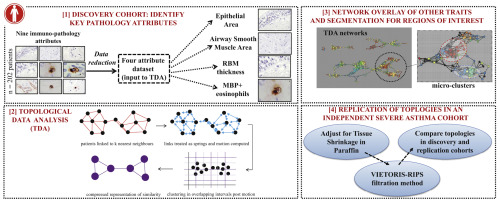Journal of Allergy and Clinical Immunology ( IF 11.4 ) Pub Date : 2018-03-14 , DOI: 10.1016/j.jaci.2017.12.982 Salman Siddiqui 1 , Aarti Shikotra 1 , Matthew Richardson 1 , Emma Doran 2 , David Choy 2 , Alex Bell 3 , Cary D Austin 2 , Jeffrey Eastham-Anderson 2 , Beverley Hargadon 1 , Joseph R Arron 2 , Andrew Wardlaw 1 , Christopher E Brightling 1 , Liam G Heaney 4 , Peter Bradding 1

|
Background
Asthma is a complex chronic disease underpinned by pathological changes within the airway wall. How variations in structural airway pathology and cellular inflammation contribute to the expression and severity of asthma are poorly understood.
Objectives
Therefore we evaluated pathological heterogeneity using topological data analysis (TDA) with the aim of visualizing disease clusters and microclusters.
Methods
A discovery population of 202 adult patients (142 asthmatic patients and 60 healthy subjects) and an external replication population (59 patients with severe asthma) were evaluated. Pathology and gene expression were examined in bronchial biopsy samples. TDA was applied by using pathological variables alone to create pathology-driven visual networks.
Results
In the discovery cohort TDA identified 4 groups/networks with multiple microclusters/regions of interest that were masked by group-level statistics. Specifically, TDA group 1 consisted of a high proportion of healthy subjects, with a microcluster representing a topological continuum connecting healthy subjects to patients with mild-to-moderate asthma. Three additional TDA groups with moderate-to-severe asthma (Airway Smooth MuscleHigh, Reticular Basement MembraneHigh, and RemodelingLow groups) were identified and contained numerous microclusters with varying pathological and clinical features. Mutually exclusive TH2 and TH17 tissue gene expression signatures were identified in all pathological groups. Discovery and external replication applied to the severe asthma subgroup identified only highly similar “pathological data shapes” through analyses of persistent homology.
Conclusions
We have identified and replicated novel pathological phenotypes of asthma using TDA. Our methodology is applicable to other complex chronic diseases.
中文翻译:

哮喘气道病理异质性:使用拓扑数据分析可视化疾病微簇
背景
哮喘是一种复杂的慢性疾病,以气道壁内的病理变化为基础。人们对结构性气道病理学和细胞炎症的变化如何影响哮喘的表达和严重程度知之甚少。
目标
因此,我们使用拓扑数据分析 (TDA) 评估病理异质性,目的是可视化疾病集群和微集群。
方法
评估了 202 名成人患者(142 名哮喘患者和 60 名健康受试者)的发现人群和外部复制人群(59 名患有严重哮喘的患者)。在支气管活检样本中检查病理学和基因表达。TDA 通过单独使用病理变量来创建病理驱动的视觉网络。
结果
在发现队列中,TDA 确定了 4 个具有多个微集群/感兴趣区域的组/网络,这些微集群/感兴趣区域被组级统计数据所掩盖。具体来说,TDA 组 1 由高比例的健康受试者组成,其中一个微簇代表一个拓扑连续体,将健康受试者与轻度至中度哮喘患者联系起来。确定了另外三个具有中度至重度哮喘的 TDA 组(气道平滑肌高组、网状基底膜高组和重塑低组),并包含许多具有不同病理和临床特征的微簇。互斥的 T H 2 和 T H在所有病理组中鉴定出 17 个组织基因表达特征。通过持续同源性分析,应用于严重哮喘亚组的发现和外部复制仅识别出高度相似的“病理数据形状”。
结论
我们已经使用 TDA 鉴定并复制了哮喘的新病理表型。我们的方法适用于其他复杂的慢性疾病。











































 京公网安备 11010802027423号
京公网安备 11010802027423号